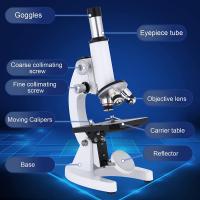What Can Be Seen Through A Light Microscope ?
A light microscope can be used to observe a wide range of specimens and structures. It allows for the visualization of various biological samples, such as cells, tissues, and microorganisms. With a light microscope, one can observe the internal structures of cells, including the nucleus, cytoplasm, and organelles. It also enables the examination of tissue sections, allowing for the study of different types of tissues and their organization. Additionally, a light microscope can be used to observe microorganisms like bacteria, fungi, and protozoa. It provides a means to study their morphology, behavior, and interactions. Overall, a light microscope is a valuable tool for investigating the microscopic world and understanding the intricate details of living organisms.
1、 Cells and cellular structures
A light microscope is a powerful tool that allows scientists to observe and study various biological specimens. It uses visible light to magnify and illuminate the sample, enabling the visualization of cells and cellular structures. Through a light microscope, scientists can explore the intricate world of living organisms and gain insights into their structure and function.
Cells, which are the basic building blocks of life, can be seen through a light microscope. This includes both animal and plant cells, as well as cells from other organisms. By staining the cells with dyes or using specialized techniques, scientists can enhance the contrast and visibility of different cellular components. This enables the observation of various cellular structures such as the nucleus, mitochondria, endoplasmic reticulum, Golgi apparatus, and cytoskeleton.
In recent years, advancements in light microscopy techniques have further expanded the capabilities of this tool. Super-resolution microscopy techniques, such as stimulated emission depletion (STED) microscopy and structured illumination microscopy (SIM), have pushed the limits of resolution beyond the diffraction barrier. This allows scientists to visualize cellular structures with unprecedented detail, revealing intricate subcellular compartments and molecular interactions.
Moreover, the development of fluorescent probes and genetically encoded fluorescent proteins has revolutionized the field of cell biology. By tagging specific molecules or organelles with fluorescent markers, researchers can track their movement and localization within cells. This has provided valuable insights into cellular processes such as protein trafficking, cell division, and signal transduction.
In conclusion, a light microscope enables the visualization of cells and cellular structures, providing a fundamental understanding of the organization and function of living organisms. With the latest advancements in microscopy techniques, scientists can delve deeper into the microscopic world, unraveling the mysteries of life at a cellular level.

2、 Microorganisms and bacteria
A light microscope is a powerful tool that allows scientists to observe and study various specimens at the cellular level. When using a light microscope, one can see a wide range of objects, including microorganisms and bacteria.
Microorganisms, also known as microbes, are tiny living organisms that are invisible to the naked eye. They include bacteria, fungi, protozoa, and viruses. With a light microscope, scientists can observe and study these microorganisms in detail. They can examine their structure, behavior, and interactions with other organisms. For example, they can observe the movement of bacteria using techniques like phase contrast microscopy or dark-field microscopy.
Bacteria, which are a type of microorganism, can also be seen through a light microscope. Bacteria are single-celled organisms that exist in various shapes and sizes. With a light microscope, scientists can observe the morphology of bacteria, such as their shape, size, and arrangement. They can also study the internal structures of bacteria, such as their cell walls, cytoplasm, and organelles.
It is important to note that the resolution of a light microscope is limited, typically around 200 nanometers. This means that smaller structures within microorganisms and bacteria, such as individual molecules or viruses, may not be visible using a light microscope alone. To study these smaller structures, scientists often use more advanced techniques like electron microscopy.
In recent years, advancements in microscopy techniques have allowed scientists to push the limits of what can be seen through a light microscope. For example, super-resolution microscopy techniques, such as stimulated emission depletion (STED) microscopy or structured illumination microscopy (SIM), have improved the resolution of light microscopes, enabling the visualization of smaller structures and details within microorganisms and bacteria.
In conclusion, a light microscope is a valuable tool for observing and studying microorganisms and bacteria. It allows scientists to examine their structure, behavior, and interactions, providing valuable insights into the world of microscopic life. However, for studying smaller structures or viruses, more advanced microscopy techniques may be necessary.

3、 Tissues and organs
A light microscope is a powerful tool that allows scientists to observe and study a wide range of biological specimens. It uses visible light to magnify and illuminate the sample, enabling researchers to visualize the intricate details of cells and tissues. Through a light microscope, various structures and processes can be observed, providing valuable insights into the organization and functioning of living organisms.
One of the primary applications of a light microscope is the examination of tissues and organs. Tissues are composed of specialized cells that work together to perform specific functions. By staining the tissue samples with dyes or using specialized techniques, scientists can observe the different types of cells present, their arrangement, and their interactions. This allows for the study of tissue architecture, cell morphology, and cellular processes such as mitosis and apoptosis.
Furthermore, a light microscope can provide information about the organization and structure of organs. Organs are composed of multiple tissues that work together to carry out specific functions. By examining thin sections of organs, scientists can observe the different tissue types present, their spatial arrangement, and any abnormalities or changes that may occur. This information is crucial for understanding organ development, function, and disease progression.
In recent years, advancements in light microscopy techniques have further expanded the capabilities of this tool. Fluorescence microscopy, for example, allows for the visualization of specific molecules or structures within cells and tissues by using fluorescent dyes or proteins. This technique has revolutionized the study of cellular processes, protein localization, and interactions within living organisms.
In conclusion, a light microscope is a valuable tool for studying tissues and organs. It enables scientists to observe the intricate details of cells, tissues, and organs, providing insights into their structure, function, and behavior. With the advent of advanced techniques, such as fluorescence microscopy, the capabilities of light microscopy have been further enhanced, allowing for more detailed and specific observations.

4、 Blood cells and other bodily fluids
What can be seen through a light microscope includes various biological specimens such as blood cells and other bodily fluids. When examining blood under a light microscope, one can observe the different types of blood cells, including red blood cells (erythrocytes), white blood cells (leukocytes), and platelets (thrombocytes). These cells can be distinguished based on their size, shape, and staining characteristics.
Red blood cells are the most abundant cells in the blood and appear as small, biconcave discs. They carry oxygen to tissues and remove carbon dioxide, and their shape allows for efficient gas exchange. White blood cells, on the other hand, play a crucial role in the immune system's defense against pathogens. They come in various types, such as neutrophils, lymphocytes, monocytes, eosinophils, and basophils, each with distinct functions in fighting infections and maintaining overall health.
Platelets are cell fragments involved in blood clotting. They appear as small, irregularly shaped structures and are responsible for forming clots to prevent excessive bleeding. By examining blood under a light microscope, abnormalities in cell count, size, shape, or distribution can be identified, aiding in the diagnosis of various diseases and disorders.
Apart from blood cells, bodily fluids like urine, saliva, and cerebrospinal fluid can also be examined using a light microscope. This allows for the detection of abnormal cells, crystals, bacteria, or other microorganisms that may indicate underlying health conditions.
It is important to note that advancements in technology have led to the development of more powerful microscopes, such as electron microscopes, which offer higher magnification and resolution. These advanced techniques allow for the visualization of even smaller structures, such as viruses and subcellular organelles. However, light microscopes remain valuable tools in routine laboratory diagnostics and provide valuable insights into the cellular composition of blood and bodily fluids.






























There are no comments for this blog.